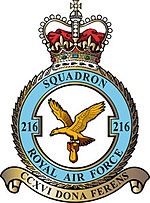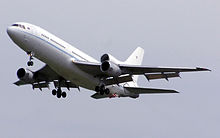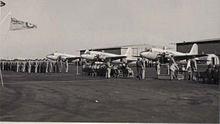- No. 216 Squadron RAF
-
No. 216 Squadron RAF 
Active 5 October 1917 - 1975
1979 -Role currently Air Transport / Air-to-Air Refuelling Garrison/HQ RAF Brize Norton Motto CCXVI dona ferens
Latin:"216 bearing gifts"Equipment Lockheed Tristar Battle honours Independent Force and Germany 1917-1918, Egypt and Libya 1940-1942, Greece 1940-1941, Syria 1941, El Alamein, North Africa 1943, North Burma 1944, South East Europe 1944-1945, Kosovo Insignia Identification
symbolAn eagle, wings elevated, holding a bomb in its claws No. 216 Squadron of the Royal Air Force operates the Lockheed Tristar K1, KC1 and C2 from RAF Brize Norton, Oxfordshire.
Contents
History
216 Squadron was formed at RAF Manston by re-numbering No. 16 Squadron RNAS when the RAF was established in 1918, hence it is always spoken of as 'two-sixteen Squadron'. Initially with the Handley Page O/100 bomber and later with the Handley Page O/400.
Between the two world wars the squadron used Vickers Vimy, Vickers Victoria and Vickers Type 264 Valentia aircraft on transport duties around the Middle East.
During World War II, No. 216 was principally a transport squadron, operating the Vickers Type 264 Valentia, Bristol Bombay, Vickers Wellington, Lockheed Hudson and Douglas Dakota. It spent a lengthy time deployed to Greece from October 1944 to August 1946 as the primary transport unit for British forces involved in the Greek Civil War.
In 1949 the Dakotas were replaced by Vickers Valletas and Handley Page Hastings transport aircraft; in 1955 the squadron moved to RAF Lyneham from RAF Fayid in Egypt to operate the DH Comet until 1975.
The squadron reformed at RAF Honington in 1979 as a maritime strike squadron assigned to SACLANT with twelve Buccaneer S2[1] aircraft transferred from the Fleet Air Arm's 809 Naval Air Squadron formerly embarked on HMS Ark Royal[2] until flying off for the last time in November 1978 for a delivery flight from the carrier in the Mediterranean to RAF St Athan. The ex-naval Buccaneers designated Buccaneer S2A by the RAF, were equipped with twelve WE.177A nuclear bombs[3] free-falling conventional HE bombs and Martel missiles for non-nuclear strike. After one year the squadron's aircraft, weapons, personnel, equipment, assignment to SACLANT, and its maritime strike role were taken over by 12 Squadron and relocated at RAF Lossiemouth.[4]
Following the Falklands War the RAF found itself lacking in the strategic transport capabilities required to sustain the expanded military presence there. This shortfall was filled initially by chartered British Airways 747 and Britannia Airways 767s. To address this in December 1982 the RAF purchased six former British Airways Lockheed Tristar 500s. The aircraft had only entered service in 1979 but had been deemed surplus to requirements.
216 Sqn was reformed in November, 1984 at RAF Brize Norton to operate the Tristar. The aircraft were operated initially in the Air-transport role but the fleet's role was eventually expanded to Air-to-Air Refuelling (AAR) with the addition of Hose/Drogue units.
The ex-BA aircraft were converted to K1 standard operating as a single point tanker, as opposed to the VC10 which has three refueling points - both wings and centre line. Four of these were converted to KC1 standard with the addition of a freight door, reinforced floor and cargo handling equipment.
In 1984 the RAF purchased a further three Tristar 500s from Pan-Am.
Of the three ex-Pan Am aircraft one was stored and the remaining two formed the backbone of the air trooping service to the Falkland Islands as Tristar C2s, carrying 267 passengers in an airline configuration. The stored aircraft was upgraded with military radios and avionics, becoming the C2A.
No. 216 Squadron has deployed the Tristar fleet in support of many high profile missions including the Gulf War (for which it received a desert paint scheme,) Operation Allied Force (Kosovo,) Operation Veritas and Operation Herrick (Afghanistan) and Operation Telic (Iraq 2003), [Operation Ellamy] (Libya).
See also
References
Notes
Bibliography
- Flintham, V. (1990) Air Wars and Aircraft: A Detailed Record of Air Combat, 1945 to the Present. Facts on File. ISBN 0816023565
Currently active Inactive 1 · 4 · 10 · 13 · 20 · 21 · 23 · 25 · 26 · 34 · 35 · 36 · 37 · 38 · 40 · 42 · 43 · 44 · 46 · 48 · 49 · 50 · 52 · 53 · 55 · 58 · 59 · 61 · 62 · 63 · 64 · 65 · 66 · 67 · 68 · 69 · 70 · 71 · 73 · 74 · 75 · 76 · 77 · 79 · 80 · 81 · 82 · 83 · 85 · 86 · 87 · 88 · 89 · 90 · 91 · 92 · 93 · 94 · 95 · 96 · 97 · 98 · 102 · 103 · 104 · 105 · 106 · 107 · 108 · 109 · 110 · 111 · 112 · 113 · 114 · 115 · 116 · 117 · 118 · 119 · 120 · 121 · 122 · 123 · 124 · 125 · 126 · 127 · 128 · 129 · 130 · 131 · 132 · 133 · 134 · 135 · 136 · 137 · 138 · 139 · 140 · 141 · 142 · 143 · 144 · 145 · 146 · 147 · 148 · 149 · 150 · 151 · 152 · 153 · 154 · 155 · 156 · 157 · 158 · 159 · 160 · 161 · 162 · 163 · 164 · 165 · 166 · 167 · 168 · 169 · 170 · 171 · 172 · 173 · 174 · 175 · 176 · 177 · 178 · 179 · 180 · 181 · 182 · 183 · 184 · 185 · 186 · 187 · 188 · 189 · 190 · 191 · 192 · 193 · 194 · 195 · 196 · 197 · 198 · 199 · 200 · 201 · 204 · 205 · 209 · 210 · 211 · 212 · 213 · 214 · 215 · 217 · 218 · 219 · 220 · 221 · 222 · 223 · 224 · 225 · 226 · 227 · 228 · 229 · 231 · 232 · 233 · 234 · 235 · 236 · 237 · 238 · 239 · 240 · 241 · 242 · 243 · 244 · 245 · 246 · 247 · 248 · 249 · 250 · 251 · 252 · 253 · 254 · 255 · 256 · 257 · 258 · 259 · 260 · 261 · 262 · 263 · 264 · 265 · 266 · 267 · 268 · 269 · 270 · 271 · 272 · 273 · 274 · 275 · 276 · 277 · 278 · 279 · 280 · 281 · 282 · 283 · 284 · 285 · 286 · 287 · 288 · 289 · 290 · 291 · 292 · 293 · 294 · 295 · 296 · 297 · 298 · 299 · 353 · 354 · 355 · 356 · 357 · 358 · 360 · 361 · 510 · 511 · 512 · 513 · 514 · 515 · 516 · 517 · 518 · 519 · 520 · 521 · 524 · 525 · 526 · 527 · 528 · 529 · 530 · 531 · 532 · 533 · 534 · 535 · 536 · 537 · 538 · 539 · 540 · 541 · 542 · 543 · 544 · 547 · 548 · 549 · 550 · 567 · 569 · 570 · 571 · 575 · 576 · 577 · 578 · 582 · 586 · 587 · 595 · 597 · 598 · 618 · 619 · 620 · 621 · 622 · 623 · 624 · 625 · 626 · 627 · 628 · 629 · 630 · 631 · 635 · 639 · 640 · 644 · 650 · 651 · 652 · 653 · 654 · 655 · 656 · 657 · 658 · 659 · 660 · 661 · 662 · 663 · 664 · 665 · 666 · 667 · 668 · 669 · 670 · 671 · 672 · 673 · 679 · 680 · 681 · 682 · 683 · 684 · 691 · 692 · 695
Australian Flying Corps (AFC) units attached
to the RAF during the First World WarCommonwealth air force units attached to
the RAF during the Second World War.Squadrons formed from non-Commonwealth
personnel during the Second World WarArgentineBelgian349 · 350CzechoslovakDutchFrenchGreek335 · 336NorwegianYugoslavRoyal Auxiliary Air Force Special ReserveAuxiliary Air ForceFleet Air Arm of the RAF (1924–1939) Categories:- Royal Air Force aircraft squadrons
Wikimedia Foundation. 2010.


